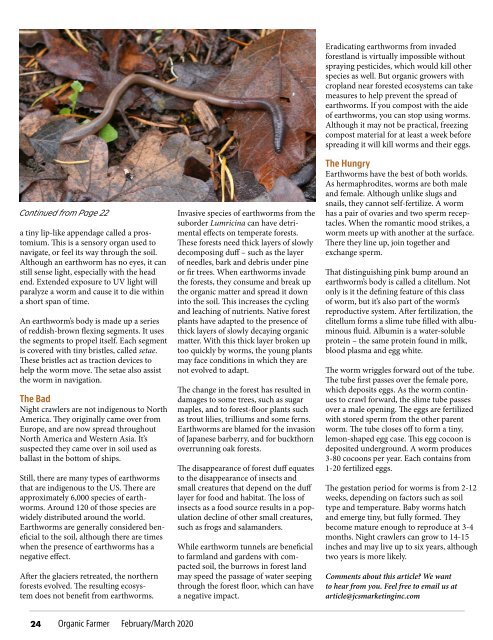You also want an ePaper? Increase the reach of your titles
YUMPU automatically turns print PDFs into web optimized ePapers that Google loves.
Continued from Page 22<br />
a tiny lip-like appendage called a prostomium.<br />
This is a sensory organ used to<br />
navigate, or feel its way through the soil.<br />
Although an earthworm has no eyes, it can<br />
still sense light, especially with the head<br />
end. Extended exposure to UV light will<br />
paralyze a worm and cause it to die within<br />
a short span of time.<br />
An earthworm’s body is made up a series<br />
of reddish-brown flexing segments. It uses<br />
the segments to propel itself. Each segment<br />
is covered with tiny bristles, called setae.<br />
These bristles act as traction devices to<br />
help the worm move. The setae also assist<br />
the worm in navigation.<br />
The Bad<br />
Night crawlers are not indigenous to North<br />
America. They originally came over from<br />
Europe, and are now spread throughout<br />
North America and Western Asia. It’s<br />
suspected they came over in soil used as<br />
ballast in the bottom of ships.<br />
Still, there are many types of earthworms<br />
that are indigenous to the US. There are<br />
approximately 6,000 species of earthworms.<br />
Around 120 of those species are<br />
widely distributed around the world.<br />
Earthworms are generally considered beneficial<br />
to the soil, although there are times<br />
when the presence of earthworms has a<br />
negative effect.<br />
After the glaciers retreated, the northern<br />
forests evolved. The resulting ecosystem<br />
does not benefit from earthworms.<br />
Invasive species of earthworms from the<br />
suborder Lumricina can have detrimental<br />
effects on temperate forests.<br />
These forests need thick layers of slowly<br />
decomposing duff – such as the layer<br />
of needles, bark and debris under pine<br />
or fir trees. When earthworms invade<br />
the forests, they consume and break up<br />
the organic matter and spread it down<br />
into the soil. This increases the cycling<br />
and leaching of nutrients. Native forest<br />
plants have adapted to the presence of<br />
thick layers of slowly decaying organic<br />
matter. With this thick layer broken up<br />
too quickly by worms, the young plants<br />
may face conditions in which they are<br />
not evolved to adapt.<br />
The change in the forest has resulted in<br />
damages to some trees, such as sugar<br />
maples, and to forest-floor plants such<br />
as trout lilies, trilliums and some ferns.<br />
Earthworms are blamed for the invasion<br />
of Japanese barberry, and for buckthorn<br />
overrunning oak forests.<br />
The disappearance of forest duff equates<br />
to the disappearance of insects and<br />
small creatures that depend on the duff<br />
layer for food and habitat. The loss of<br />
insects as a food source results in a population<br />
decline of other small creatures,<br />
such as frogs and salamanders.<br />
While earthworm tunnels are beneficial<br />
to farmland and gardens with compacted<br />
soil, the burrows in forest land<br />
may speed the passage of water seeping<br />
through the forest floor, which can have<br />
a negative impact.<br />
Eradicating earthworms from invaded<br />
forestland is virtually impossible without<br />
spraying pesticides, which would kill other<br />
species as well. But organic growers with<br />
cropland near forested ecosystems can take<br />
measures to help prevent the spread of<br />
earthworms. If you compost with the aide<br />
of earthworms, you can stop using worms.<br />
Although it may not be practical, freezing<br />
compost material for at least a week before<br />
spreading it will kill worms and their eggs.<br />
The Hungry<br />
Earthworms have the best of both worlds.<br />
As hermaphrodites, worms are both male<br />
and female. Although unlike slugs and<br />
snails, they cannot self-fertilize. A worm<br />
has a pair of ovaries and two sperm receptacles.<br />
When the romantic mood strikes, a<br />
worm meets up with another at the surface.<br />
There they line up, join together and<br />
exchange sperm.<br />
That distinguishing pink bump around an<br />
earthworm’s body is called a clitellum. Not<br />
only is it the defining feature of this class<br />
of worm, but it’s also part of the worm’s<br />
reproductive system. After fertilization, the<br />
clitellum forms a slime tube filled with albuminous<br />
fluid. Albumin is a water-soluble<br />
protein – the same protein found in milk,<br />
blood plasma and egg white.<br />
The worm wriggles forward out of the tube.<br />
The tube first passes over the female pore,<br />
which deposits eggs. As the worm continues<br />
to crawl forward, the slime tube passes<br />
over a male opening. The eggs are fertilized<br />
with stored sperm from the other parent<br />
worm. The tube closes off to form a tiny,<br />
lemon-shaped egg case. This egg cocoon is<br />
deposited underground. A worm produces<br />
3-80 cocoons per year. Each contains from<br />
1-20 fertilized eggs.<br />
The gestation period for worms is from 2-12<br />
weeks, depending on factors such as soil<br />
type and temperature. Baby worms hatch<br />
and emerge tiny, but fully formed. They<br />
become mature enough to reproduce at 3-4<br />
months. Night crawlers can grow to 14-15<br />
inches and may live up to six years, although<br />
two years is more likely.<br />
Comments about this article? We want<br />
to hear from you. Feel free to email us at<br />
article@jcsmarketinginc.com<br />
24<br />
<strong>Organic</strong> <strong>Farmer</strong> <strong>February</strong>/<strong>March</strong> <strong>2020</strong>


















